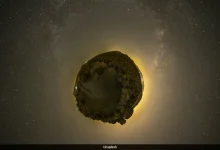
In a stark revelation, the National Oceanic and Atmospheric Administration’s (NOAA) 2023 Arctic Report Card has documented the highest summer surface air temperatures in the Arctic since records began in 1900.
This alarming trend underscores the region’s rapid warming, which is occurring at twice the global average rate due to anthropogenic climate change.
The report, released on Tuesday, paints a grim picture of the cascading effects of the Arctic’s transformation. Not only did this year witness extraordinary wildfires and melting glaciers, but it also signaled potential global catastrophes, including rising sea levels that could devastate coastal communities worldwide.
The Canadian Arctic Archipelago and parts of northern Canada experienced unprecedented warmth coupled with lower-than-average precipitation, fueling an extreme wildfire season. Meanwhile, Greenland’s ice sheet continued its relentless decline, shedding approximately 350 trillion pounds (158.7 billion metric tons) of mass, a trend unbroken since 1998.
Although this year’s loss was mitigated by significant snowfall, the enduring heat inflicted notable damage. Summit Station, perched atop Greenland’s ice sheet, recorded melting for only the fifth time in over three decades. The cumulative melt-day area nearly reached record highs, indicating extensive and persistent thawing.
The NOAA report warns of “irreversible climate harms” as the overheating Arctic’s repercussions ripple through North America and Eurasia. Brenda Ekwurzel, the director of climate science at the Union of Concerned Scientists, emphasizes that these impacts will have long-term consequences beyond the Arctic Circle.
Adding to the complexity of the situation is the “unequivocal evidence of Arctic greening.” Warmer temperatures, increased precipitation, and thawing permafrost are causing a shift in vegetation patterns, with shrubs and trees encroaching upon grasslands and tundra.
This year, the North American tundra exhibited significant greening, while the Eurasian Arctic saw less. The phenomenon of “peak tundra greenness” reached its third-highest level in 24 years, raising concerns about the release of vast amounts of carbon dioxide previously locked within the permafrost.
The Arctic’s plight serves as a clarion call for immediate action against climate change. As the region’s role as a global air conditioner diminishes due to the loss of reflective sea ice, the darker ocean surface absorbs more sunlight, exacerbating the warming effect.
With summer Arctic sea ice extent shrinking by 12.2% per decade, the implications for global weather patterns, ecosystems, and human societies are profound and far-reaching.
As the world grapples with these findings, the message is clear: the Arctic’s distress is a harbinger of global environmental upheaval, demanding urgent attention and concerted efforts to mitigate the climate crisis.
















